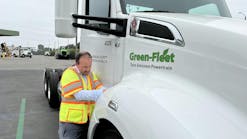In an era where it’s fashionable to talk about the government only in terms of waste and spending, there is real change—and real savings—going on within the U.S. Air Forces Europe.
With vehicles in 42 locations in 35 countries, the U.S. Air Forces Europe’s Command Vehicles Branch, with a replacement value of $800 million, faces unique challenges. The diverse ground transportation requirements have included partner-building missions in 13 African countries, maintaining search-and-recovery vehicles, and supporting post-earthquake humanitarian efforts with vehicles in Turkey.
USAF Europe is one of two winners of the 2012 Fleet Masters Award, along with Waste Management. The award is presented each year by Construction Equipment and the Association of Equipment Management Professionals (AEMP), and is judged on categories such as finance (financial management, acquisition, warranty and performance guarantees); information management (benchmarking, life-cycle costing, specifications, and technology); policies (safety, employee training, environmental and human resources); and controls (outsourcing, parts management, preventive maintenance, and shop and facilities management).
There was even the logistics assignment for 95 vehicles and 38 technicians supporting sorties in last year’s Operation Odyssey Dawn, which protected Libyan civilians during that nation’s civil war.
When you think of the types of vehicles under USAF Europe’s command, it’s easy to imagine everything from anti-ambush vehicles to military police cars to airfield fuel trucks to mass transit buses. You don’t think of hybrids, but the Air Force is thinking of them every day.
“We’re responsible for transforming the Air Force’s European and African vehicle fleet to meet demanding Federal energy mandates,” says Master Sergeant Andrew Slater, USAF Europe. “That includes hybrid and electric technology, as well as alternative fuels.”
A 2007 executive order directs that Federal agencies acquire a specific minimum level of alternative fueled vehicles (AFVs). It also mandates the use of alternative fuels in AFVs 100 percent of the time, when appropriate, and requires increasing alternative fuels consumption by 10 percent a year through 2015, using 2005 as a baseline.
Further, the order also calls for total reduction of petroleum consumption by 2 percent a year through 2015, requiring the use of plug-in hybrids when acquisition costs and life-cycle costs are reasonably comparable to non-hybrid vehicles.
“Our organization consistently reviews fleet initiatives to include U.S. and E.U. alternative fueling infrastructure options such as hydrogen, natural gas, and plug-in electric technology,” Slater says. “We fought for an additional $750,000 in acquisition funding to get 95 alternative-fueled vehicles, which gave us the Air Force’s largest sub-command hybrid fleet.”
So far, using strict vehicle classifications has enabled the command to reduce ground transportation fossil fuel use by 11 percent.
They’ve also taken steps to go green in vehicle maintenance. U.S. Air Forces Europe requires the recycling of solid and liquid waste, and the procurement of products manufactured from recycled materials. They also require re-refined oil, and retread or post-consumer content tires, as well as reclaimed engine coolant.
“Either the coolant must be purchased as reclaimed, or the unit must reclaim their own coolant,” Slater says. “Our particular defense supply center sells both reclaimed and virgin engine coolant. It requires that
reclaimed coolant contain a minimum of 50 percent reclaimed ethylene glycol.”
All USAF Europe units must track all recycled/reclaimed antifreeze consumed and report the costs for the entire year.
To combat wastewater pollution, USAF Europe bought an aircraft de-icing vehicle with glycol recovery technology. That purchase prevented $200,000 in environmental fines from German authorities.
And, USAF Europe introduced a self-contained rubber removal vehicle to its inventory, which removes airfield rubber and pavement markings, and stores them for environmental disposal. This vehicle alone eliminated $1.3 million in annual contract costs.
In addition to environmentally related changes and savings, USAF Europe has honed its fleet management craft to realize savings in a number of other areas:
- Initiated a theater-wide fleet reconciliation of 8,000 vehicles and correctly realigned $22.5 million in new vehicle acquisitions
- Right-sized the fleet by studying fleet utilization and removing 210 obsolete vehicle requirements to avert $10.5 million in future vehicle purchases without impacting agile combat support
- Identified old storage procedures and restructured 785 assets from a Cold War, deep storage configuration to an expeditionary, rapid deployment posture
- Identified 85 war reserve reductions and slashed $7.9 million in funding requirements.
“We maintain a strong reputation as an outstanding steward of public resources,” Slater says





